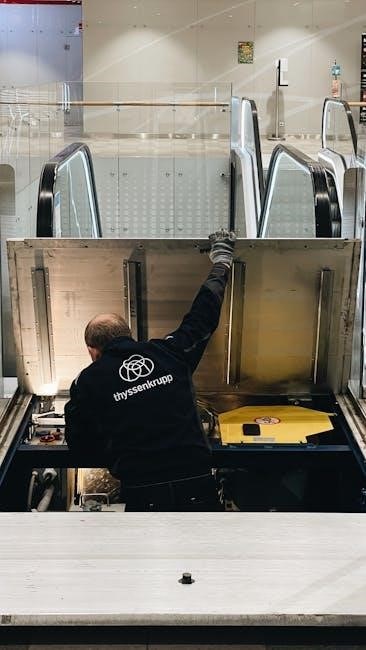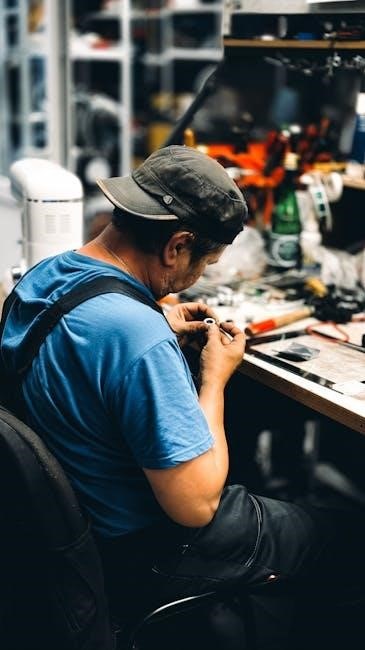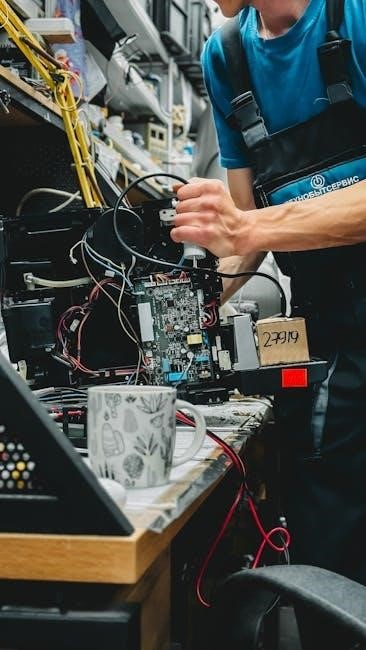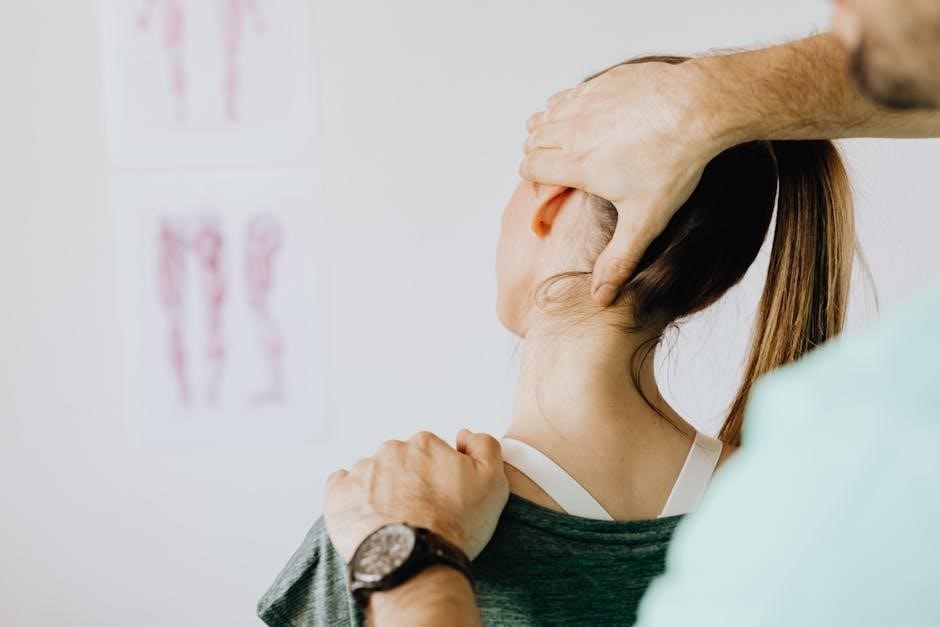
Overview of Patella Tendon Repair Rehabilitation Protocol
The patella tendon repair rehabilitation protocol is a structured, post-operative plan designed to ensure safe and effective recovery. It emphasizes early rehabilitation, physical therapy, and home exercises to restore strength, mobility, and function. The protocol is divided into phases, each with specific goals and timelines to protect the repair while progressively increasing activity. Supervised therapy and adherence to guidelines are crucial to avoid complications and achieve optimal outcomes.

1.1 Importance of Early Rehabilitation
Early rehabilitation is critical after patella tendon repair to minimize pain, prevent stiffness, and promote healing. Initiating exercises like quadriceps activation and ankle pumps within days post-surgery helps maintain muscle function and joint mobility. Delaying therapy can lead to prolonged recovery, muscle atrophy, and reduced functional outcomes. Early intervention also enhances patient motivation and adherence to the rehabilitation process, laying the foundation for successful progression through subsequent phases of recovery.
1.2 Goals of the Rehabilitation Process
The primary goals of patella tendon repair rehabilitation include restoring knee range of motion, strengthening the quadriceps and surrounding muscles, and achieving functional recovery. The process aims to eliminate pain, improve joint stability, and ensure the tendon heals properly. Additionally, the protocol focuses on preventing complications, such as tendon stretching or rerupture, while preparing the patient for gradual return to daily activities and sports. Achieving these goals ensures a safe and effective transition to full recovery and optimal function.
Phase 1: Immediate Post-Operative Period (0-2 Weeks)
Phase 1 focuses on protecting the repair, minimizing pain, and initiating gentle exercises. Immobilization, pain management, and early activation of quadriceps and ankle pumps are prioritized during this period.

2.1 Weight Bearing Status and Brace Use
Weight-bearing status is typically limited during the immediate post-operative period to protect the repair. Patients often use crutches and wear a hinged knee brace locked in extension to minimize stress on the tendon. The brace is usually set between 0 and 30 degrees to allow for immobilization while promoting healing. Weight-bearing progression is gradual, with full weight-bearing typically allowed after a few weeks, depending on the surgeon’s guidelines and patient tolerance. Compliance with brace use is crucial during this phase.
2.2 Range of Motion Guidelines
Range of motion (ROM) is carefully managed to protect the repair while promoting healing. Initially, patients are advised to avoid bending the knee beyond 90 degrees to minimize stress on the tendon. Passive knee extension to 0 degrees is permitted to maintain joint mobility. Gentle, controlled movements are encouraged to prevent stiffness without risking repair integrity. These guidelines aim to balance healing and early mobilization, ensuring optimal recovery outcomes. Strict adherence to ROM limits is crucial during the initial post-operative phase.
2.3 Initial Exercises (Quadriceps Activation, Ankle Pumps, etc.)
Initial exercises focus on maintaining muscle activation and joint mobility without stressing the repair. Quadriceps activation, such as quadriceps setting, is essential to prevent atrophy. Ankle pumps are used to enhance blood flow and reduce swelling. Straight leg raises in multiple directions (flexion, abduction, adduction) strengthen surrounding muscles. Passive knee extension to 0 degrees is also performed to maintain joint mobility. These exercises are low-stress, promoting early recovery while protecting the tendon repair. They are typically done within pain-free ranges to ensure compliance and safety.
Phase 2: Strengthening and Mobility (Weeks 2-6)
This phase introduces resistance exercises like short/long arc quads and progresses knee flexion beyond 90 degrees, focusing on strengthening and improving joint mobility safely.
3.1 Progression of Knee Flexion (Beyond 90 Degrees)
Progression of knee flexion beyond 90 degrees is carefully managed to avoid stressing the repair. Gentle mobilization and controlled exercises are introduced, ensuring pain-free movement. The focus is on gradually increasing flexibility without compromising tendon integrity. Patients are monitored closely to prevent overextension, and exercises are adjusted based on individual healing progress and clinical assessment.
3.2 Introducing Resistance Exercises (Short/Long Arc Quads)
Resistance exercises, such as short and long arc quadriceps exercises, are introduced to strengthen the knee without overloading the tendon. Short arc quads focus on small knee movements, while long arc quads involve full range of motion with resistance. These exercises are progressed gradually, ensuring controlled movements and avoiding excessive stress on the repair. Clinical monitoring is essential to adjust resistance levels and ensure proper form, promoting strength gains while safeguarding the tendon’s integrity.

Phase 3: Advanced Strengthening and Functional Activities (Weeks 6-12)
This phase focuses on advanced strengthening, functional activities, and eccentric exercises to enhance muscle endurance and prepare for daily activities and sports-specific movements.
4.1 Eccentric Hamstring and Glute Activation

Eccentric hamstring and glute activation exercises are introduced to enhance muscle endurance and strength. These exercises focus on controlled lengthening of the hamstrings and glutes, improving functional movement patterns. Activities such as deadlifts, glute bridges, and Nordic curls are commonly used. Progression includes resistance bands or weights to increase intensity. Emphasis is placed on proper form to avoid excessive knee stress. Strengthening these muscle groups is critical for restoring knee stability and preparing for higher-level functional activities.
4.2 Single-Leg Balance and Core Strengthening
Single-leg balance exercises are introduced to improve proprioception and stability. Patients perform single-leg stands or balance board activities to enhance neuromuscular control. Core strengthening focuses on exercises like planks, bird dogs, and pelvic tilts to stabilize the lower extremities. Progression includes dynamic balance drills and functional movements. These exercises reduce injury risk and improve overall knee stability, preparing the patient for advanced functional activities and sports-specific movements.

Phase 4: Return to Sport and Full Activity (Weeks 12+)
This phase focuses on restoring full functional abilities, enabling return to sports and daily activities. Criteria include full ROM, strength, and functional progression through elliptical, bike, and advanced exercises.
5.1 Criteria for Returning to Sports (Full ROM, Strength, etc.)
Return to sports requires full knee range of motion, strength equal to 90% of the contralateral side, and functional progression. Criteria include single-leg balance, core stability, and eccentric hamstring strength. Patients must demonstrate ability to perform sport-specific movements without pain or instability. Functional activities like elliptical, bike, and advanced exercises are progressed to mimic athletic demands, ensuring readiness for dynamic sports participation while minimizing risk of re-injury or tendon stress.
5.2 Functional Progression (Elliptical, Bike, etc.)

Functional progression incorporates low-impact cardiovascular exercises like elliptical, stationary bike, and swimming to improve endurance without stressing the tendon. These activities are gradually introduced to enhance muscle activation and coordination. Sport-specific drills are added to mimic athletic movements, ensuring a smooth transition to dynamic activities. Progression is based on pain-free participation and symmetrical movement patterns, preparing the patient for the demands of their sport or activity while minimizing the risk of re-injury.

Key Considerations and Avoidance
Protecting the tendon repair is critical. Avoid excessive stress, such as deep knee flexion or heavy resistance, to prevent re-injury. Adherence to the protocol ensures optimal healing and minimizes complications.
6.1 Avoiding Knee Flexion Stretching
Knee flexion stretching should be avoided to prevent stress on the repaired tendon. Patients are advised not to bend their knee beyond 90 degrees during the initial healing phases. This precaution minimizes the risk of re-injury and ensures proper tendon repair. Gentle mobilization and controlled exercises are recommended instead to maintain range of motion without compromising the repair site.
6.2 No External Load/Resistance to Quadriceps
Avoiding external load or resistance to the quadriceps is critical during early rehabilitation to protect the tendon repair. Patients should refrain from exercises that apply additional stress, such as weighted squats or resistance bands, to prevent re-injury. Focus is placed on active range-of-motion exercises, like quadriceps setting and short/long arc quads, to promote strength without overloading the tendon. This approach ensures a safer recovery and gradual return of function.

Role of Physical Therapy and Home Exercise Programs
Physical therapy begins 1-3 days post-surgery, focusing on exercises like ankle pumps and straight leg raises. Supervised sessions are recommended 3 times weekly, with home exercises crucial for recovery and patient compliance key to achieving optimal outcomes.
7.1 Supervised PT Sessions (Frequency and Focus)
Supervised physical therapy sessions typically begin 1-3 days post-surgery, with a recommended frequency of 3 times per week. The focus is on reducing swelling, improving range of motion, and strengthening the surrounding muscles. Early exercises include straight leg raises, passive knee extension, and gentle mobilization. The therapist ensures proper alignment and avoids stress on the repair. These sessions are critical for guiding progression and preventing complications, with adjustments made based on individual recovery and clinical judgment.
7.2 Home Exercise Program Compliance
Compliance with a home exercise program is vital for successful recovery. Patients are advised to begin exercises 1-3 days post-surgery, focusing on ankle pumps, straight leg raises, and passive knee extensions. These activities promote strength and mobility without stressing the tendon repair. Consistency is key, with exercises performed multiple times daily. Proper form and adherence to guidelines, such as avoiding quadriceps stretching and resistance, ensure optimal healing and prevent complications. Regular follow-ups with a therapist help monitor progress and reinforce the importance of home program compliance.

Monitoring Progress and Adjustments
Regular clinical assessments ensure proper healing and functional improvement. Adjustments are made based on individual progress, with a focus on safely advancing exercises and activities.
8.1 Clinical Judgment and Individualization
Clinical judgment is essential for tailoring the rehabilitation process to each patient’s unique needs. Individualization ensures that the protocol adapts to factors like tissue quality and patient response, optimizing recovery. Supervised therapy allows therapists to assess progress and modify exercises accordingly. This personalized approach ensures that the rehabilitation aligns with the patient’s specific healing timeline, balancing protection of the repair with gradual progression toward functional goals.
8.2 Weaning from Supervised Therapy
Weaning from supervised therapy occurs as the patient demonstrates improved strength, range of motion, and ability to perform exercises independently. This transition is gradual, with reduced frequency of supervised sessions while emphasizing adherence to the home exercise program. Criteria for weaning include consistent progress, pain management, and the patient’s ability to safely perform advanced exercises without supervision. Continued monitoring ensures the patient maintains proper form and avoids setbacks during the transition to independent rehabilitation.
The patella tendon repair rehabilitation protocol successfully guides patients through recovery, balancing protection and progression. Adherence to the structured approach ensures optimal clinical outcomes and return to function.
9.1 Summary of Rehabilitation Goals and Outcomes
The primary goal of patella tendon repair rehabilitation is to restore knee function, strength, and mobility while minimizing complications. Outcomes focus on achieving full range of motion, returning quadriceps strength, and enabling patients to resume daily activities and sports safely; Success is measured by the absence of pain, stable tendon repair, and the patient’s ability to perform functional tasks without limitation, ensuring a durable recovery and preventing future injury.
9.2 Importance of Adherence to the Protocol
Adherence to the patella tendon repair rehabilitation protocol is crucial for optimal recovery. Proper compliance ensures timely healing, minimizes risks of re-injury, and achieves full functional restoration. Deviations may prolong recovery or lead to suboptimal outcomes. Consistency in exercises and therapy sessions, along with avoiding prohibited activities, is essential for achieving the desired results and returning to pre-injury activities safely and effectively. Patient commitment is key to a successful and durable rehabilitation process.